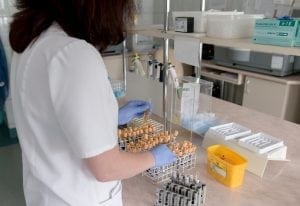According to OncLive, Oncolytics Biotech and Roche are pairing up to run a new German Phase ½ clinical trial. The GOBLET trial will evaluate pelareorep in conjunction with atezolizumab (Tecentriq) for patients with including colorectal, pancreatic, and anal cancers. Overall, participants will not begin enrollment until the first few months of 2021.
Pelareorep and Atezolizumab
During the trial, researchers will evaluate a combination treatment of atezolizumab and pelareorep. The latter drug is administered intravenously, making it more accessible and targeted than other treatment options. The therapy is delivered using a reovirus. Pelareorep can enter normal cells, but cannot replicate in them, making it a safe option. Once administered, it prompts an immune response and promotes tumor lysis, or the rupturing or degeneration of tumors.
Clinical Trial
Within the GOBLET study, researchers will evaluate the safety, efficacy, and tolerability of pelareorep and atezolizumab for colorectal, pancreatic, and anal cancers. Ultimately, the main endpoints will look at overall response rate and specific biomarkers. Altogether, researchers anticipate 55 enrolled participants across four cohorts:
- Cohort One: 14 participants with metastatic colorectal cancer will enroll. Patients will receive a combination of pelareorep, TAS-102, and atezolizumab.
- Cohort Two: 19 patients with metastatic colorectal cancer will enroll. Patients will receive a combination treatment consisting of pelareorep and atezolizumab.
- Cohort Three: 12 patients with metastatic pancreatic cancer will enroll. Patients will receive pelareorep, atezolizumab, gemcitabine, and nab-paclitaxel.
- Cohort Four: 10 patients with advanced anal cancer will enroll. Patients will receive pelareorep and atezolizumab.
Pelareorep has shown promise in prior trials of patients with colorectal cancer when combined with bevacizumab and FOLFIRI. While the drug combinations do have some side effects, such as nausea, fatigue, and diarrhea; pelareorep and its combinations seem relatively well-tolerated.
Anal Cancer
Typically, cancer occurs when genetically mutated abnormal cells begin to accumulate, crowding out healthy cells and forming a tumor. In the case of anal cancer, the abnormal cells begin in the anal canal, a short tube at the end of the rectum where stool exits the body. Typically, anal cancer impacts those who are over 60 years old. Additional risk factors include HPV, immunosuppressive drug use, smoking cigarettes, a high amount of sexual partners, and anal sex. Symptoms include:
- Anal pain, bleeding, and itching
- A mass or growth in the anal canal
- Changes in bowel movements
- A “full” feeling
- Incontinence
- Swollen lymph nodes
Learn more about anal cancer.
Pancreatic Cancer
Pancreatic cancer forms in the pancreas, an organ which sits behind the lower part of the stomach. Normally, the pancreas releases enzymes and hormones, which help with food digestion and blood sugar management. When pancreatic cancer develops, it can occur in a few forms, including pancreatic neuroendocrine tumors (which form in neuroendocrine cells) and pancreatic adenocarcinoma, which begins in the pancreatic ducts. Risk factors include obesity, smoking, and a family history. Men are slightly more likely to have pancreatic cancer than women. Additionally, most patients are 45 years old or older.
Many patients with pancreatic cancer will not experience symptoms until later stages. When symptoms appear, they may include:
- Diabetes
- Unintended weight loss
- Fatigue
- Dark urine and light stools
- Depression and anxiety
- Blood clots
- Obstructed bowel
- Jaundice (yellowing of the eyes and skin)
- Appetite loss
- Abdominal and back pain
Learn more about pancreatic cancer.







